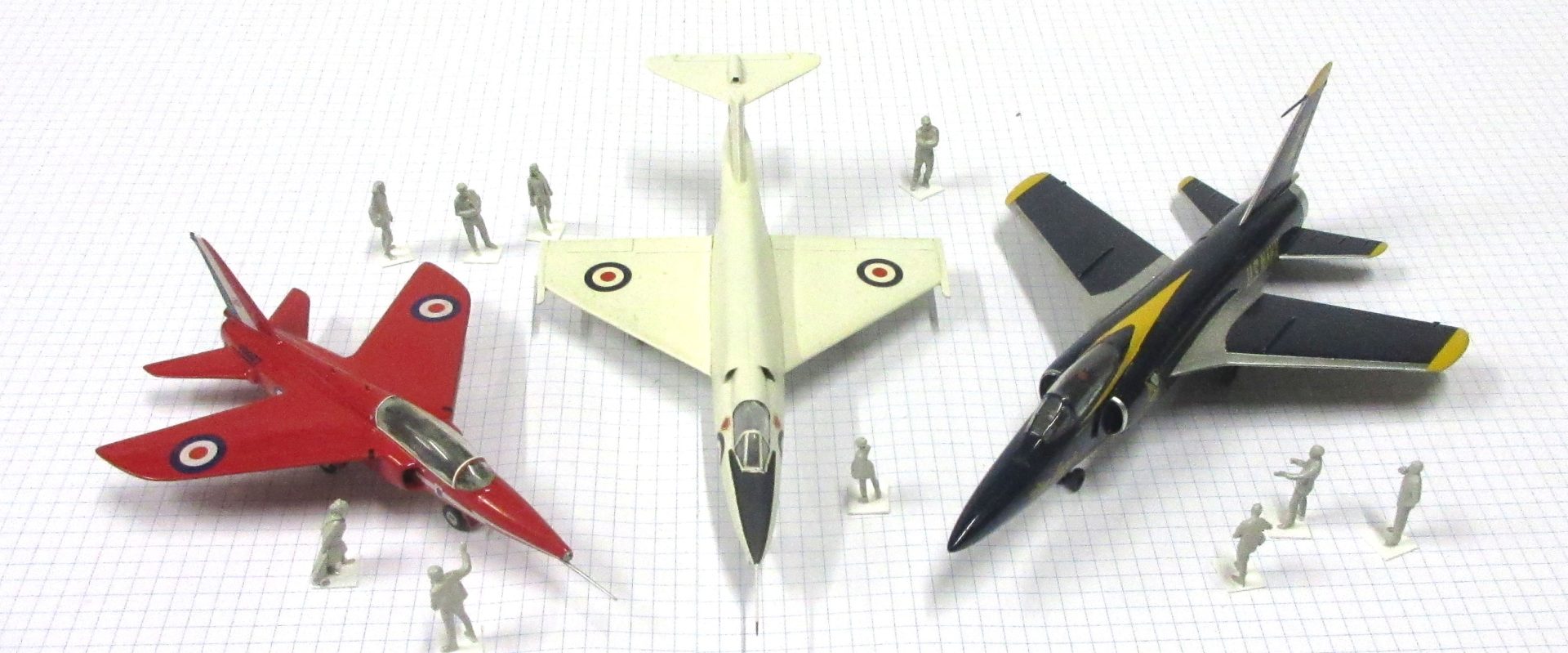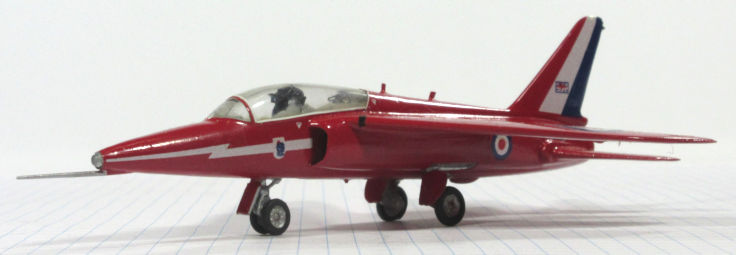Red, White and Blue
Hawker Siddeley Hawk T.1 – Saunders Roe SR.53 – Grumman F11F-1

Not all military aircraft are camouflaged in drab colours designed so people can’t see them in all their loveliness. Occasionally aircraft are painted in vivid colours to make them visible to spectators, auch as the aircraft flown by display teams to entertain and amaze the masses. It is also useful to paint prototype aircraft so that observers can view their performance. So, here are three highly visible military aircraft in the national colours of many countries, red, white and blue (or bleu, blanch et rouge, si vous préfères).
Hawker Siddeley Gnat T.1 in 1/72 by Airfix
This aircraft was initially designed as a light and inexpensive fighter by the Folland company. The first one made its first flight in July 1955 and it was subsequently flown by the air forces of Finland and India. Britain’s Royal Air Force was not interested in the fighter version but became interested in the version that was modified as a two seat trainer. The Gnat T.1 began entering service in 1962 and served as the RAF’s initial fast jet trainer until 1974. The Gnat T.1 became extremely well known as the mount for the RAF’s ‘Red Arrows’ aerobatic team between 1964 and 1979.
When it comes to kits of this model you have two choices, the Airfix kit first published in 1964 and the Matchbox kit that was first published in 1972. This model was made from the Airfix kit which a fairly basic thing, as you might imagine. I’m old enough that I can remember when it was first published in the plastic bag with header and in a standard trainer scheme. After the Red Arrows team was formed all the reboxings were in that scheme. Avoid that kit if you can and pick up the retooled 2012 Airfix kit that has been boxed in in a standard trainer scheme and in the ‘Yellowjacket’ scheme that pretended the Red Arrows and also in the Red Arrows scheme. The review in Modelling Madness calls this a ‘little gem’ and the detailed review on Kit Maker Network agrees. As for the Matchbox kit, it is adequate according to the review in Modelling Madness if you can find one cheaply.
Saunders Roe SR.53 in 1/72 by Airfix
This aircraft was a prototype interceptor designed and built in the 1950s. It’s role was similar to that of the German Messerschmitt Me163 rocket fighter of World War 2, to climb rapidly to high altitude powered by a rocket motor to shoot down enemy bombers. It would then use a jet engine to return to base. Two prototypes were ordered and the first one flew in May 1957. They performed well and were good aircraft to fly but, by then, the development of long range and high altitude surface to air missiles had taken over the interceptor role and the project was cancelled. One of the prototypes crashed during testing and the other is on display at the Royal Air Force Museum, Cosford.
I made this model from the ancient Airfix kit that was first published in 1958. It needed a bit of work to make it presentable by 2000s standards, including replacement decals. If you want to make a model of this aircraft throw out the Airfix kit and get the Azmodels kit that was first published in 2017. It is not, apparently, a great kit and the You Tube review on Gary’s Stuff rates it as ‘okay’ and the build review on the Britmodeller forum is a bit more generous.
Grumman F11F-1 Tiger in 1/72 by Hasegawa
Design of this aircraft began with the intention of improving the performance of the Grumman F9F Cougar. However, the aircraft had changed so much that it was given a new designation. The prototype first flew in July 1954 and it was the first US Navy aircraft to exceed the speed of sound. They began entering service in 1956 but were withdrawn from carrier service in 1961 because they were outclassed by the Vought F8U Crusader which entered service only a year later and because of engine reliability problems. They became popular and well known, however, as the mount for the US Navy’s aerobatic team, the Blue Angles, between 1957 and 1969.
Strangely, for one of the most elegant aircraft ever made, there is only one kit of it available. Fortunately for us all it is from Hasegawa, first published in 1981. It has been reboxed with different decals a dozen times since then so it shouldn’t be hard to find. I found it a delight to make, Modelling Madness recommends it highly and so do I.



